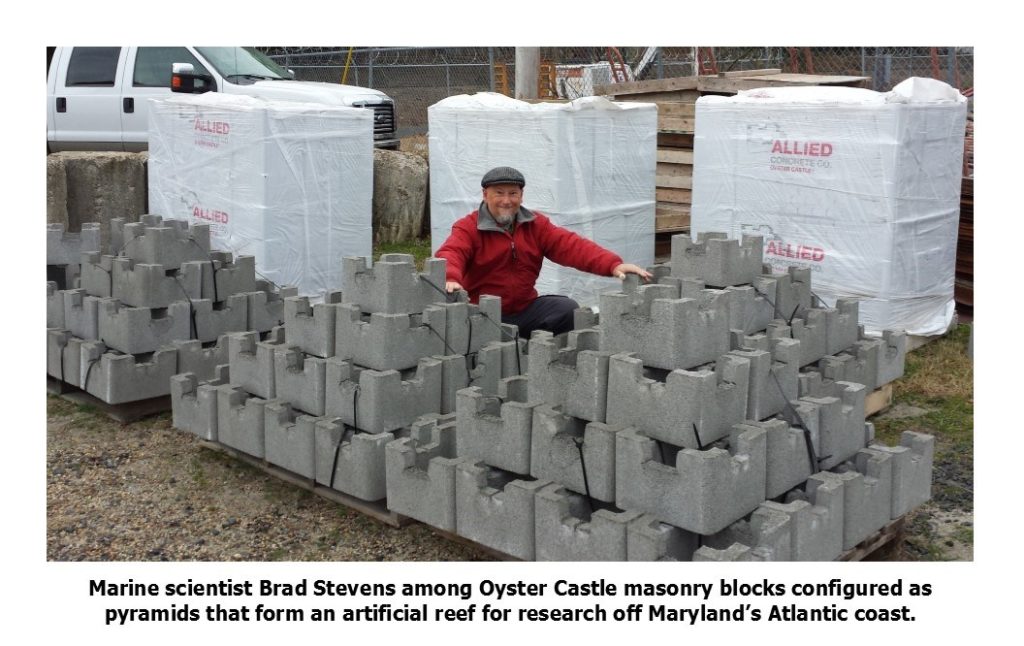
Marine researchers aim to nurture sea bass habitats
Friday, February 3, 2017
Four days prior to Christmas, the University of Maryland Eastern Shore put down a deposit on a small plot of real estate along the state’s Atlantic coast.
The location is 10 miles east of Ocean City some 50-to-60 feet underwater.
Resting on the ocean floor are 330 concrete blocks configured in 30 structures of varying sizes – each resembling a pyramid – and not to be confused with the terrestrial structure by the same name in the 9500 block of Coastal Highway.
Funded by a $216,000 grant, UMES marine scientists built an artificial reef to test whether a strategically designed, man-made environment might attract black sea bass and tautog, two species popular with fishermen.
Neither species is considered endangered, but neither do marine scientists know much about their habits – and habitats.
Should UMES’ reef design prove successful, Dr. Bradley Stevens said it could eventually help improve recreational fishing opportunities for the benefit of tourism and the economy.
Stevens and Cara Schweitzer, a doctoral candidate from Missouri in UMES’ Marine, Estuarine, and Environmental Science program, drew inspiration for their pyramid-block design from pre-fabricated structures known as Oyster Castles used to revive the mollusk population.
Schweitzer bound the blocks together using industrial-strength plastic zip ties. They, in turn, were stacked atop wooden pallets and carefully lowered to the ocean floor in late December.
Schweitzer identified an unobstructed spot for a reef easily accessible and could be studied at regular intervals; it also happens to lie between two existing reefs. As soon as the ocean warms up this May, she will don scuba gear to begin a series of up-close observations over the next two years.
The “research reef,” as Stevens calls it, provides a rare opportunity to measure “how it is used by sea bass in that particular area, if at all.”
“Artificial reefs,” said Stevens, the project’s principal investigator, “are a big deal because they help expand limited habitat.”
Five tons of porous masonry blocks should attract invertebrates and other sea life more quickly than metal objects like scuttled ships and subway cars.
The location UMES selected is under permit held by the non-profit Ocean City Reef Foundation, which agreed to let the university conduct its experiment. Schweitzer found few tautog and black sea bass were evident in an underwater survey she conducted during the summer of 2016 in the area under Foundation control.
The reef’s pre-assembled building blocks were deployed by the 103-foot marine vessel “Iron Lady,” under the command of Capt. Jeremiah Kogon, who also shuttles scientists out for their diving trips aboard another craft, the “OC Dive Boat.”
The project is a collaboration between UMES, the Mid-Atlantic Fishery Management Council, the National Fish Habitat Fund and The Atlantic Coast Fish Habitat Partnership (ACFHP), which awarded Stevens the grant “to study black sea bass habitat characteristics, fish abundance and fish diets in the Mid-Atlantic.”
Stevens and Schweitzer will be gathering evidence to:
- Determine whether black sea bass have a preference for particular habitats and if UMES’ design affects their abundance and feeding ecology.
- Gain an understanding of the ocean floor’s biodiversity and how sea life responds to “surface roughness … and other habitat characteristics.”
- Determine if linking “isolated habitat patches” can be successfully achieved.
Borrowing a strategy conservationists employ to fill in habitat gaps on land, Schweitzer envisions UMES’ concrete reef potentially evolving into a “corridor bridge” between the nearby older reefs.
“We expect coral and sponges will cover the reef blocks and link them together,” Schweitzer said. “It’s a unique opportunity to look at the recruitment of fish and fouling organisms to an artificial reef from scratch.”
Kent Smith, ACFHP’s steering committee chairman, said his organization and its “collaborative partners are excited about the unique opportunity to work together over the next few years to collect data that will inform both science and management, and support healthy fisheries in the Mid-Atlantic region.”
The Atlantic Coast Fish Habitat Partnership is part of a national network that “works to conserve fish habitat nationwide (by) leveraging federal, state, tribal and private funding … to achieve the greatest impact on fish populations through priority conservation projects.”


